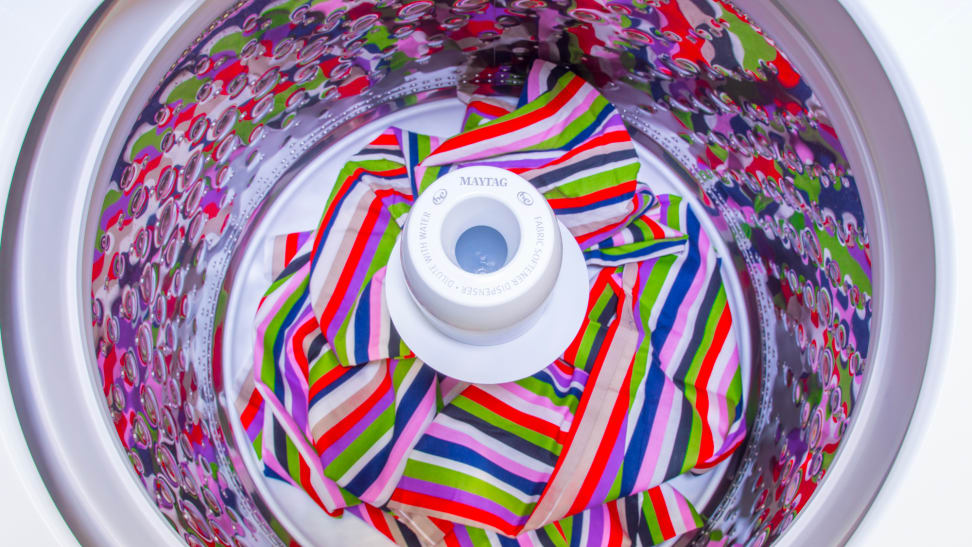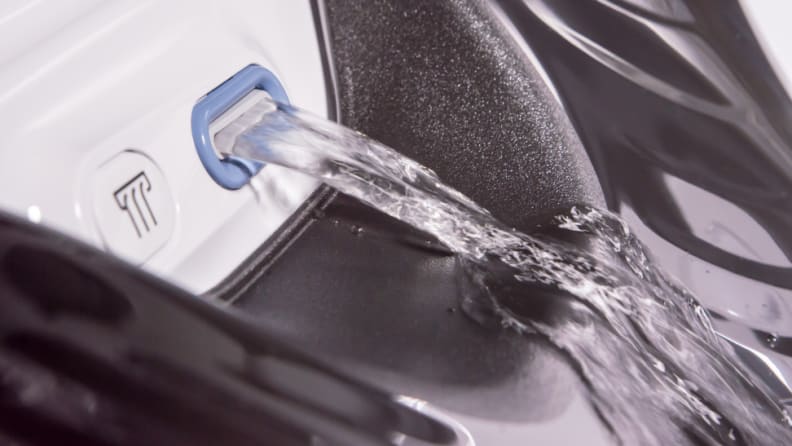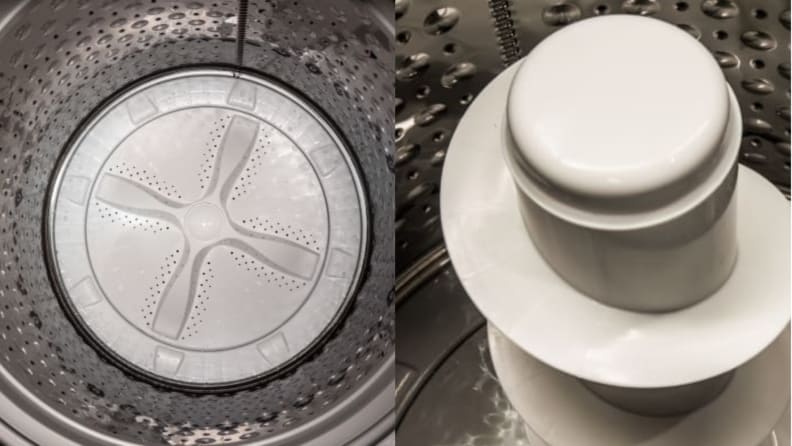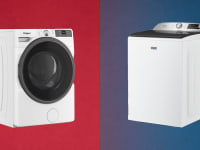Spoiler alert! Here's how your washing machine cleans your clothes
A little agitation goes a long way
 Credit:
Reviewed / Kyle Hamilton
Credit:
Reviewed / Kyle Hamilton
Products are chosen independently by our editors. Purchases made through our links may earn us a commission.
Sometimes it's helpful to know how the appliances in your life actually work. Knowing how a fridge circulates its air or that different burners on your range have higher BTUs can help you use these tools more effectively.
When it comes to washing machines, whether you're in need of repairs or just gearing up to buy a new one, it's always helpful to review the basics of the product space. Here's a quick primer on what helps your washer actually wash things.
Here's how a washing machine gets clothes clean

Water flows into the washing machine's tub. High-efficiency washers use much less water than old fashioned washing machines to get clothes clean.
There are three basic pillars behind a successful wash cycle: water, mechanical action, and detergent.
Water is the universal solvent, which seems like a pretty good place to start if you're trying to wash something away. It also provides a great medium in which clothes can tumble around freely, which is important for creating mechanical action.
Mechanical action is the scrubbing. All washers have some form of paddle they use to toss clothes around. In front-loaders, these paddles are often along the interior of the drum, which keeps clothes tumbling. Top-loaders have agitators and impellers, fixtures that sit at the bottom of the drum and stir up its contents. Scrubbing is important, because it allows the detergent to do its thing more effectively.
Detergent is where the magic (science) happens. Detergents reduce the surface tension of the water, which allows it to permeate more easily. Detergents also have molecules that are attracted to oils on one end and water on the other end, which means the detergent sticks onto any oils on your clothes and then gets scrubbed out into the water by the mechanical action.
(If you want to maximize your laundry routine to get your wearables cleaner, faster, check out this article on laundry tips and tricks.)
During a wash cycle, your machine does this
Very briefly, for those who don't have a clear-top washer and some time on their hands, here's what happens under the lid during a wash cycle.
- The tub spins slowly to balance and sense the load inside the washing machine.
- Water pours over the detergent dispenser, integrating the suds, and begins filling up the tub.
- The machine pauses as detergent dissolves in the washer.
- The tub moves back and forth, agitating the clothes and supplying the mechanical action that scrubs out stains.
- Dirty water drains out of the drum, followed by a short spin cycle to get out even more water.
- The washer refills with clean water for the rinse cycle. This gets out any remaining detergent and dirt.
- The washer drains again, followed by a spin cycle that gets as much water out of the clothes as possible. It's much more energy efficient to get out water this way than by using a dryer.
At this point your laundry is clean, damp but not soaking, and ready for a tumble dry.
Typically, your washing machine lets you choose a number of options to customize each load. These options often involve tweaking the settings like water temperature and level, or adding new phases and features to the cycle like sanitize or extra rinse cycles. Some washers will let you save your custom cycles on the device itself, to let you quickly and easily reuse them later.
There is a difference between agitators and impellers

There are two forms of mechanical action in a top-loading washing machine: an impeller (at left) and a pole agitator (at right).
For top-loading washing machines, there's two main ways to add mechanical action: an agitator or an impeller.
Pole agitators stick out of the base of the drum and their sides are often lined with vertically-oriented paddles to help push everything around. This design harkens back to the 1960s, and often comes bundled with heaps of nostalgia. Contemporary washing machines with pole agitators that perform well include the LG WT7305CV and GE GTW685BSLWS.
Impellers are curved panels that sit at the base of the drum and are squat and wide instead of tall and thin. The paddles are often aligned radially, as in the GE GTW720BSNWS.
While the physical differences of the two designs are obvious, what might not be as obvious is why the impeller is superior: By keeping itself flat against the bottom of the drum, it actually gives the clothes much more room to toss around freely throughout the whole drum.
The pole agitator, by comparison, offers a much more limited range of motion. Its tall build blocks the whole center of the drum, which means its rotations can only impel clothes into a limited back-and-forth motion. It's also a lot easier for this limited motion to put more stress on your clothes than necessary. In fact, older top-loaders with pole agitators used to be fairly harsh on your clothes, often significantly exacerbating wear and tear.
While modern washers with this design are much gentler, that harsh mechanical action is also how these washers used to scrub out stubborn stains: Newer top-loaders with pole agitators often offer the worst of both worlds, sacrificing their cleaning power for a less gentle wash than you'd get from an impeller washer or front-loader.
Understand the value variability between top-loaders and front-loaders

While the value of a top-loader over that of a front-loader is a huge debate in the world of washers, it's also a topic that science has more or less settled: Front-loaders are better washers. It's true that front-loaders didn't earn a good reputation when they entered the market, over the years their performance has improved considerably (though there are still some safety concerns for those with pets or young kids).
Well-performing front-loaders—like the Electrolux EFLS627UTT and LG WM3700HWA—are far more gentle and yet have more cleaning power than most top-loaders, although for older folks or people with back and leg problems they can be a pain to load.
A less obvious difference between the two washing machine styles is that their size and design affects how you can place them in your home. Top-loading washers can only be placed side by side with their dryer counterpart, whereas front-load washers can stacked vertically with their dryers. This is something to consider if you're short on space, when the ability to stack your washer and dryer may be more valuable than cleaning capabilities.
Extras can make all the difference—or not
Extra features almost always add to the price of your washing machine, but they may not always offer a ton of value. Before buying, it's important to go over a washer's feature set and figure out if those options will be helpful to you or if they will just deplete your bank account.
Here's some common extra features that you may or may not want in a new washer.
- Sanitize—Sanitize modes make sure the water used for a cleaning cycle is heated up to at least 140°F, which can help kill certain bacteria. This mode is helpful for parents with newborns or people with particularly dirty jobs.
- Steam—Steam modes have three main functions: sanitizing, increasing the efficacy of some detergents, and reducing wrinkles.
- Remote control—Smart washers often allow you to control them via a smartphone app, allowing you to start a cycle remotely. Apps and their features often have niche usefulness on a washer. If you can't imagine why you'd need this feature, you probably don't.
- Extra water—We're calling out this feature not because its particularly inscrutable, but because it perpetuates the laundry myth that more water gets your clothes cleaner. Unless your clothes are completely caked in mud, more water actually means your clothes will get less clean.


